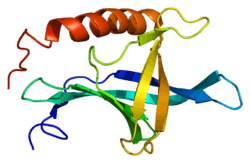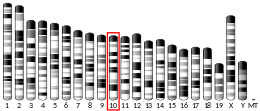RGPD5
RANBP2-like and GRIP domain-containing protein 5 is a protein that in humans is encoded by the RGPD5 gene.[5][6][7]
RAN is a small GTP-binding protein of the RAS superfamily that is associated with the nuclear membrane and is thought to control a variety of cellular functions through its interactions with other proteins. This gene shares a high degree of sequence identity with RANBP2, a large RAN-binding protein localized at the cytoplasmic side of the nuclear pore complex. It is believed that this RANBP2 gene family member arose from a duplication event 3 Mb distal to RANBP2. Alternative splicing has been observed for this locus and two variants are described. Additional splicing is suggested but complete sequence for further transcripts has not been determined.[7]
Interactions
RGPD5 has been shown to interact with Transportin 1.[8]
References
- GRCh38: Ensembl release 89: ENSG00000015568 - Ensembl, May 2017
- GRCm38: Ensembl release 89: ENSMUSG00000003226 - Ensembl, May 2017
- "Human PubMed Reference:". National Center for Biotechnology Information, U.S. National Library of Medicine.
- "Mouse PubMed Reference:". National Center for Biotechnology Information, U.S. National Library of Medicine.
- Ciccarelli FD, von Mering C, Suyama M, Harrington ED, Izaurralde E, Bork P (March 2005). "Complex genomic rearrangements lead to novel primate gene function". Genome Research. 15 (3): 343–51. doi:10.1101/gr.3266405. PMC 551560. PMID 15710750.
- Hillier LW, Graves TA, Fulton RS, Fulton LA, Pepin KH, Minx P, et al. (April 2005). "Generation and annotation of the DNA sequences of human chromosomes 2 and 4". Nature. 434 (7034): 724–31. Bibcode:2005Natur.434..724H. doi:10.1038/nature03466. PMID 15815621.
- "Entrez Gene: RGPD5 RANBP2-like and GRIP domain containing 5".
- Cai Y, Miao SY, Wang LF (October 2001). "[Determination of the binding site of testis-specific nucleoporin BS-63 to transportin (karopherin beta 2) and the proof of their combination in vitro]". Zhongguo Yi Xue Ke Xue Yuan Xue Bao. Acta Academiae Medicinae Sinicae. 23 (5): 462–6. PMID 12905863.
Further reading
- Cai Y, Miao SY, Wang LF (October 2001). "[Determination of the binding site of testis-specific nucleoporin BS-63 to transportin (karopherin beta 2) and the proof of their combination in vitro]". Zhongguo Yi Xue Ke Xue Yuan Xue Bao. Acta Academiae Medicinae Sinicae. 23 (5): 462–6. PMID 12905863.
- Cai Y, Gao Y, Sheng Q, Miao S, Cui X, Wang L, Zong S, Koide SS (January 2002). "Characterization and potential function of a novel testis-specific nucleoporin BS-63". Molecular Reproduction and Development. 61 (1): 126–34. doi:10.1002/mrd.1139. PMID 11774384.
- Wiemann S, Weil B, Wellenreuther R, Gassenhuber J, Glassl S, Ansorge W, Böcher M, Blöcker H, Bauersachs S, Blum H, Lauber J, Düsterhöft A, Beyer A, Köhrer K, Strack N, Mewes HW, Ottenwälder B, Obermaier B, Tampe J, Heubner D, Wambutt R, Korn B, Klein M, Poustka A (March 2001). "Toward a catalog of human genes and proteins: sequencing and analysis of 500 novel complete protein coding human cDNAs". Genome Research. 11 (3): 422–35. doi:10.1101/gr.GR1547R. PMC 311072. PMID 11230166.
- Wang LF, Zhu HD, Miao SY, Cao DF, Wu YW, Zong SD, Koide SS (1999). "Molecular cloning and characterization of a novel testis-specific nucleoporin-related gene". Archives of Andrology. 42 (2): 71–84. doi:10.1080/014850199262904. PMID 10101573.
- Nothwang HG, Rensing C, Kübler M, Denich D, Brandl B, Stubanus M, Haaf T, Kurnit D, Hildebrandt F (February 1998). "Identification of a novel Ran binding protein 2 related gene (RANBP2L1) and detection of a gene cluster on human chromosome 2q11-q12". Genomics. 47 (3): 383–92. doi:10.1006/geno.1997.5119. PMID 9480752.





